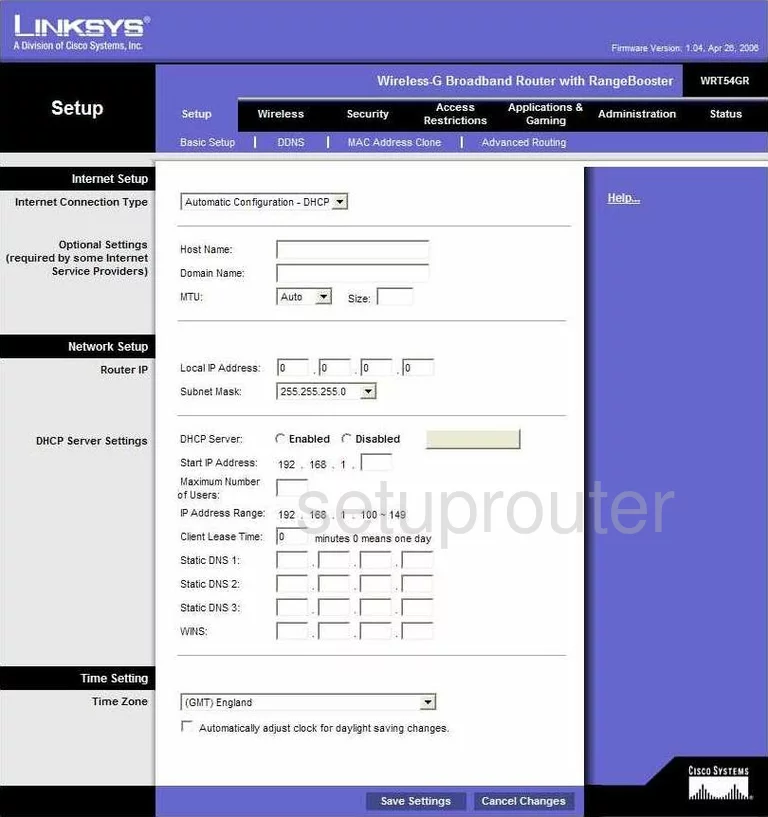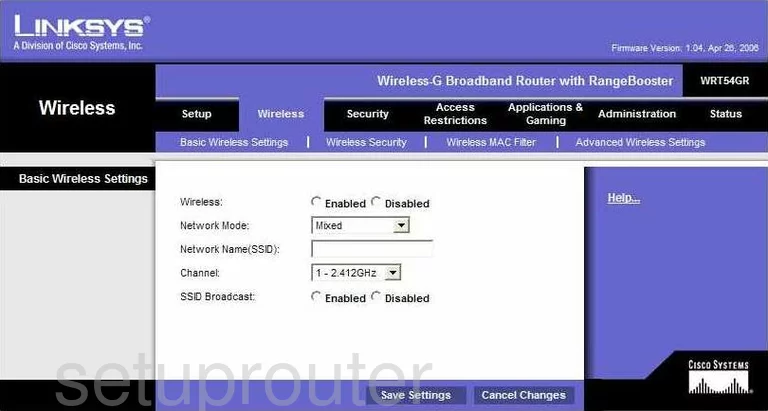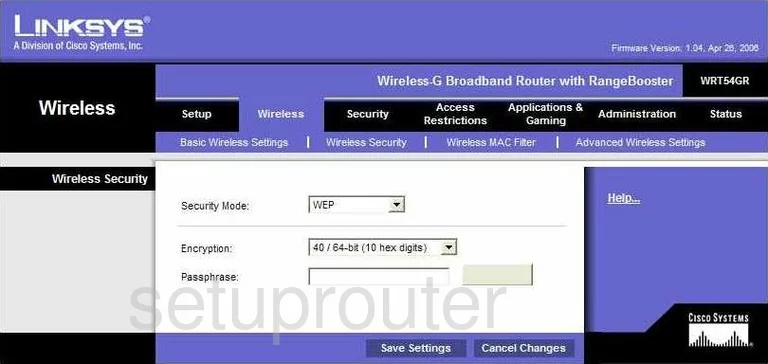The Linksys WRT54GR router is considered a wireless router because it offers WiFi connectivity. WiFi, or simply wireless, allows you to connect various devices to your router, such as wireless printers, smart televisions, and WiFi enabled smartphones.
Other Linksys WRT54GR Guides
This is the wifi guide for the Linksys WRT54GR. We also have the following guides for the same router:
- Linksys WRT54GR - How to change the IP Address on a Linksys WRT54GR router
- Linksys WRT54GR - Linksys WRT54GR User Manual
- Linksys WRT54GR - Linksys WRT54GR Login Instructions
- Linksys WRT54GR - How to change the DNS settings on a Linksys WRT54GR router
- Linksys WRT54GR - How to Reset the Linksys WRT54GR
- Linksys WRT54GR - Information About the Linksys WRT54GR Router
- Linksys WRT54GR - Linksys WRT54GR Screenshots
WiFi Terms
Before we get started there is a little bit of background info that you should be familiar with.
Wireless Name
Your wireless network needs to have a name to uniquely identify it from other wireless networks. If you are not sure what this means we have a guide explaining what a wireless name is that you can read for more information.
Wireless Password
An important part of securing your wireless network is choosing a strong password.
Wireless Channel
Picking a WiFi channel is not always a simple task. Be sure to read about WiFi channels before making the choice.
Encryption
You should almost definitely pick WPA2 for your networks encryption. If you are unsure, be sure to read our WEP vs WPA guide first.
Login To The Linksys WRT54GR
To get started configuring the Linksys WRT54GR WiFi settings you need to login to your router. If you are already logged in you can skip this step.
To login to the Linksys WRT54GR, follow our Linksys WRT54GR Login Guide.
Find the WiFi Settings on the Linksys WRT54GR
If you followed our login guide above then you should see this screen.

Beginning on the Basic Setup page of the Linksys WRT54GR router click Wireless at the top of the page.
Change the WiFi Settings on the Linksys WRT54GR

This should take you to a page that looks similar to the one you see above.
- Wireless - Enable this setting in order to turn on your wireless network.
- Network Mode - Our recommendation is to set this to Mixed.
- Network Name (SSID) - This is the name you create in order to identify your internet connection. It doesn't matter what you enter here but we advise you to stay away from using personal information. Learn more in our Wireless Name Guide.
- Channel - For the least amount of interference everyone should use channels 1,6, or 11. Learn why in our WiFi Channels Guide.
- SSID Broadcast - If you want to hide your SSID click the Disabled button. This doesn't completely keep you safe from hackers. You can still find hidden networks using the right tools.
- Save Settings - Tick this button near the bottom of the page in order to apply the changes you just made.
Now go back to the top of the page and click Wireless Security.

On this new page you can make some changes to the security settings for your wireless network.
- Security Mode - We recommend setting this to PSK2. This is the same thing as WPA2 PSK. Learn why this is the best option by reading our WEP vs. WPA guide.
- Encryption - Pick AES if given an option.
- Passphrase - This is the password you use to access your network. We recommend creating a strong password of at least 14-20 characters. Try and use some symbols, numbers, and capital letters in this password. Learn more tips in our Choosing a Strong Password Guide.
- Key Renewal - Go ahead and leave this at the default setting of 3600 seconds.
- Save Settings - Tick this in order to save your changes.
Possible Problems when Changing your WiFi Settings
After making these changes to your router you will almost definitely have to reconnect any previously connected devices. This is usually done at the device itself and not at your computer.
Other Linksys WRT54GR Info
Don't forget about our other Linksys WRT54GR info that you might be interested in.
This is the wifi guide for the Linksys WRT54GR. We also have the following guides for the same router:
- Linksys WRT54GR - How to change the IP Address on a Linksys WRT54GR router
- Linksys WRT54GR - Linksys WRT54GR User Manual
- Linksys WRT54GR - Linksys WRT54GR Login Instructions
- Linksys WRT54GR - How to change the DNS settings on a Linksys WRT54GR router
- Linksys WRT54GR - How to Reset the Linksys WRT54GR
- Linksys WRT54GR - Information About the Linksys WRT54GR Router
- Linksys WRT54GR - Linksys WRT54GR Screenshots